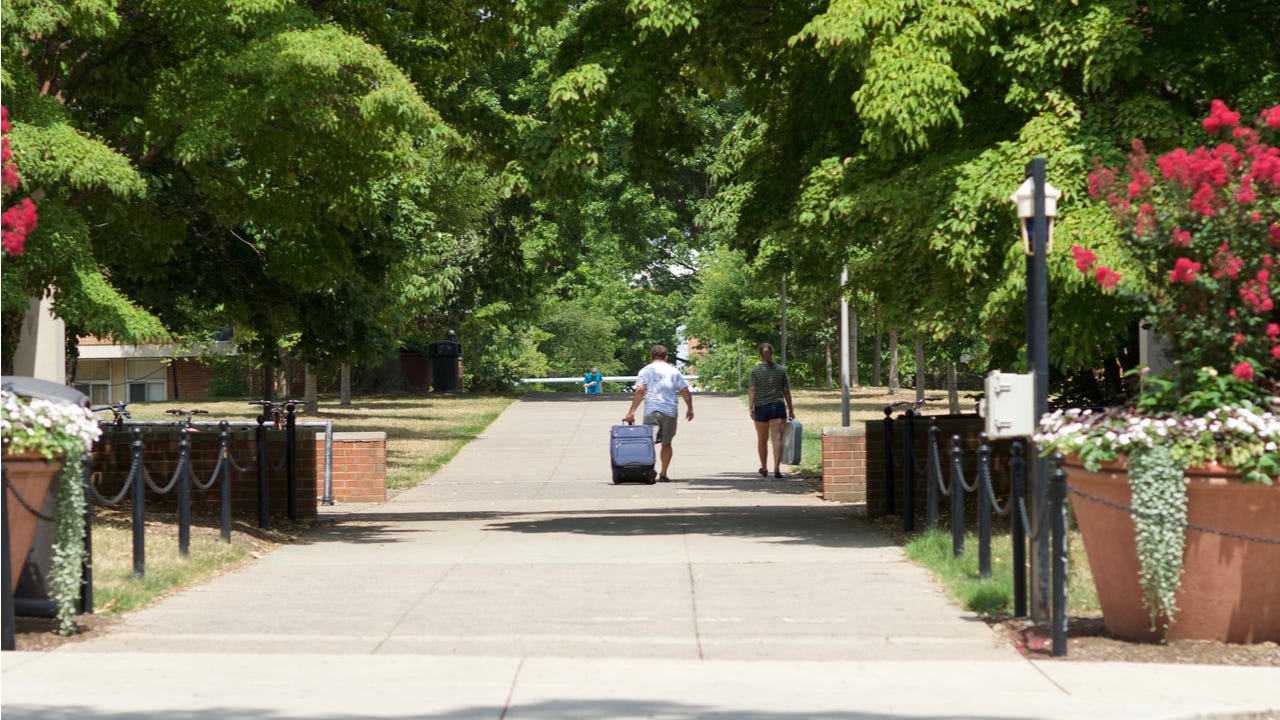First-year college costs: 10 expenses to prepare for beyond tuition

The Bankrate promise
At Bankrate we strive to help you make smarter financial decisions. While we adhere to strict , this post may contain references to products from our partners. Here's an explanation for .
Key takeaways
- As you prepare to settle at your home away from home, it’s vital to estimate the costs you’ll incur beyond tuition to avoid any surprises
- First-year college can be steep and vary depending on the college and where you live
- Be careful not to overlook hidden costs, like clothing, transportation and medical care when preparing your budget
First-year college students have to think about more than tuition and housing when it comes to paying for college.
On average, estimated costs when attending public, four-year institutions were $28,840 for in-state students and $46,730 for out-of-state students. The cost increases to $60,420 for four-year students attending private nonprofit schools, according to a recent CollegeBoard report.
Because going to school is expensive, a college budget needs to account for more than just your tuition but also class supplies, transportation, medical care and more. This is true even if you plan on applying for student loans, as the amount of financial aid you qualify for may not cover all your first-year costs.
10 costs to prepare for as a first-time college student
First-time college students may be surprised when bills for their first semester roll in. To avoid unexpected costs, create a budget in advance that accounts for all of the costs of college.
The estimated costs for each item below are taken from nationwide averages, but your expenses will vary depending on the school you attend, your financial situation and more. The cost of supplies, for instance, is different for English majors than for engineering majors, and not everyone will choose to join Greek life or study abroad. To get the most accurate estimate of your costs, consult your school’s website and conduct a financial audit.
1. Books and supplies
The costs of necessary learning materials, such as textbooks, notebooks, calculators, backpacks and more, can easily reach hundreds of dollars per semester. However, college professors will typically release the class syllabus and book requirements in advance, so you have time to find less-expensive options beyond the campus bookstore.
To save money on textbooks each semester, consider renting your books or buying them used. Some courses, however, require one-time online access codes, and those can’t be rented or bought used.
Estimated cost: $1,250 to $1,470 per year
2. Technology
While most libraries have computers for student use, going through college without a laptop or other personal computer is nearly impossible. Many professors have gone paperless now, with homework, essays and assignments being completed fully online. Some exams and classes are even hosted online now, so it’s important to have a personal device to complete your coursework on time.
Some schools offer laptop rentals, so check with student services or the library before making a large purchase. To cut costs, you may also consider buying a refurbished or pre-owned device instead of a new one.
Estimated cost: $500 to $950
3. Dorm furnishings and personal items
Necessities like a desk, a chair, a twin bed, a closet, basic storage and utilities are included in the cost of room and board if you stay in on-campus dorms. However, other necessary furnishings aren’t included. Students are responsible for providing items like pillows, bed furnishings, personal decor and basic appliances. This includes things like coffee makers, water filters, minirefrigerators and microwaves.
While basic appliances aren’t necessities for everyone, they’re convenient and useful for those late-night study sessions or when the dining hall isn’t open. Some schools have rentals for refrigerators and microwaves, so check with your housing and residence life department before budgeting for these items.
You’ll also need to cover the cost of personal items for your dorm, like toiletries and cleaning supplies. Look into how much you spend in a month on toiletries to get an idea of how much you’ll need to set aside, and coordinate with your roommate on what cleaning supplies you’ll bring to help divvy up the cost.
Estimated cost: $1,300 to $1,400 per year
- Grants
- Scholarships
- Private student loans
4. Study abroad programs
Studying abroad is an exciting, once-in-a-lifetime opportunity to take college classes in a different country. Most programs last one semester.
While these international schools typically have a tuition agreement with your college, they come with additional costs on top of your usual tuition. You’ll need to factor in room and board, meals, airfare, health insurance coverage and sightseeing or excursion costs. While studying abroad can be expensive, there are ways to cut costs, and many study abroad programs offer need-based scholarships. Talk to the office of study abroad to see what it would cost you to study outside of the country and how you can save money.
Estimated cost: $7,000 to $15,000
5. Groceries and dining out
The campus dining hall is convenient, but most don’t offer 24/7 services. If you have a meal plan, set aside extra money for those all-nighters and late-night food runs. If you don’t have a meal plan, you’ll need to plan for a larger grocery budget.
When you shop for snacks, coffee or microwavable meals, keep your budget minimal by shopping at discount stores, and be on the lookout for sales, coupons or rewards cards. It’s also smart to create meal plans and bring a shopping list so you don’t risk buying more than you truly need.
Estimated cost: $200 to $700 per month
6. Medical care
Most colleges have health centers that offer basic medical services and over-the-counter medication for little to no cost, but you’ll often need to pay a mandatory “health service fee” each semester. If you need a prescription filled or have costs not covered by the medical center, you’ll also have to pay for these yourself. On top of that, some colleges require additional student health insurance.
Colleges list the health service fee, among other attendance fees, on their websites. Check the website or call your school’s health center if you have questions about what’s covered and what’s not. In some cases, you may be able to request a fee waiver.
Estimated cost: $2,700 to $3,600 per year
7. Clothing
Students attending school far from home and living on campus for the entirety of the academic year may want to budget for clothing, especially if they’re moving to a different climate. For instance, students living in California and attending school in the Midwest should factor in the cost of snow boots and heavy winter coats.
To save money, shop at thrift and consignment stores or host a “clothing swap” with some friends. During a swap, everyone brings clothing items that they no longer wear and trade items. It’s a great way to update your closet or get the seasonal clothing you need for free.
Estimated cost: $100 to $200 per year
8. Greek life
For some, joining a sorority or fraternity is essential to the college experience. With that said, application fees and yearly dues could leave you on the hook for potentially thousands of dollars per year.
Dues are charged either by semester or by year. There are also new member fees, which vary based on the organization you’re joining and the school you attend.
Before rushing, check to see if the dues are listed anywhere on your school’s website or if you can find the national websites for the organizations on your campus. If you know the cost beforehand, you can be more selective about the organization you join.
Estimated cost: $300 to $3,000 per year
9. Transportation
Every college student needs to consider potential transportation costs, even those living on campus full-time without a car. Those choosing to have their car on campus will have to account for a parking pass and gas costs. Your school’s parking and transportation services department should have the parking pass cost listed on their website.
If you choose not to have a car on campus, iron out all transportation costs before the academic year begins — including the cost of visiting home during the holidays. Depending on where you live, you could always catch a ride with a friend to save money, but if you’re traveling across the country, compare airfare costs with other forms of transportation, like a bus or train.
Estimated cost: $1,000 to $2,000 per year
10. A savings account and emergency fund
It’s never too early to start a savings account and an emergency fund. The sooner you start saving, the better off you’ll be in the future. Many banks offer student checking and savings accounts with decent rates and no fees. If you have a part-time job while you’re in college, putting even a small portion of your paycheck into savings will put you in a better position in an emergency, especially if it’s a high-yield savings account.
Estimated cost: Ideally 10 to 20 percent of your income
Bottom line
Entering your first year of college can be intimidating, especially as you navigate the financial requirements. To help prepare, begin by calculating your expenses for the year and building a budget. Your college or university should have a robust financial aid section on its website, which can give you a good idea of average costs per semester or year. From there, you can look at your financial aid package and determine what your next steps will be. While it may seem overwhelming at first, having a plan and budget can make your first year far more manageable and enjoyable.
